check engine light Seat Alhambra 2009 Owner's Manual
[x] Cancel search | Manufacturer: SEAT, Model Year: 2009, Model line: Alhambra, Model: Seat Alhambra 2009Pages: 285, PDF Size: 7.62 MB
Page 6 of 285
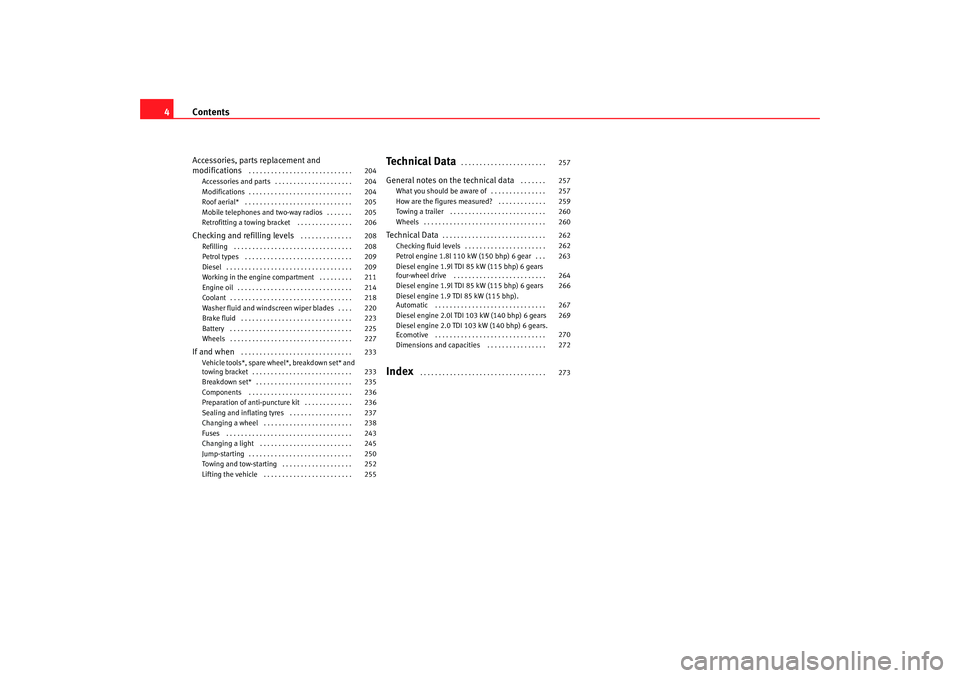
Contents
4Accessories, parts replacement and
modifications
. . . . . . . . . . . . . . . . . . . . . . . . . . . .
Accessories and parts . . . . . . . . . . . . . . . . . . . . .
Modifications . . . . . . . . . . . . . . . . . . . . . . . . . . . .
Roof aerial* . . . . . . . . . . . . . . . . . . . . . . . . . . . . .
Mobile telephones and two-way radios . . . . . . .
Retrofitting a towing bracket . . . . . . . . . . . . . . .
Checking and refilling levels
. . . . . . . . . . . . . .
Refilling . . . . . . . . . . . . . . . . . . . . . . . . . . . . . . . .
Petrol types . . . . . . . . . . . . . . . . . . . . . . . . . . . . .
Diesel . . . . . . . . . . . . . . . . . . . . . . . . . . . . . . . . . .
Working in the engine compartment . . . . . . . . .
Engine oil . . . . . . . . . . . . . . . . . . . . . . . . . . . . . . .
Coolant . . . . . . . . . . . . . . . . . . . . . . . . . . . . . . . . .
Washer fluid and windscreen wiper blades . . . .
Brake fluid . . . . . . . . . . . . . . . . . . . . . . . . . . . . . .
Battery . . . . . . . . . . . . . . . . . . . . . . . . . . . . . . . . .
Wheels . . . . . . . . . . . . . . . . . . . . . . . . . . . . . . . . .
If and when
. . . . . . . . . . . . . . . . . . . . . . . . . . . . . .
Vehicle tools*, spare wheel*, breakdown set* and
towing bracket . . . . . . . . . . . . . . . . . . . . . . . . . . .
Breakdown set* . . . . . . . . . . . . . . . . . . . . . . . . . .
Components . . . . . . . . . . . . . . . . . . . . . . . . . . . .
Preparation of anti-puncture kit . . . . . . . . . . . . .
Sealing and inflating tyres . . . . . . . . . . . . . . . . .
Changing a wheel . . . . . . . . . . . . . . . . . . . . . . . .
Fuses . . . . . . . . . . . . . . . . . . . . . . . . . . . . . . . . . .
Changing a light . . . . . . . . . . . . . . . . . . . . . . . . .
Jump-starting . . . . . . . . . . . . . . . . . . . . . . . . . . . .
Towing and tow-starting . . . . . . . . . . . . . . . . . . .
Lifting the vehicle . . . . . . . . . . . . . . . . . . . . . . . .
Te c h n i c a l D a t a
. . . . . . . . . . . . . . . . . . . . . . .
General notes on the technical data
. . . . . . .
What you should be aware of . . . . . . . . . . . . . . .
How are the figures measured? . . . . . . . . . . . . .
Towing a trailer . . . . . . . . . . . . . . . . . . . . . . . . . .
Wheels . . . . . . . . . . . . . . . . . . . . . . . . . . . . . . . . .
Te ch n ica l D ata
. . . . . . . . . . . . . . . . . . . . . . . . . . . .
Checking fluid levels . . . . . . . . . . . . . . . . . . . . . .
Petrol engine 1.8l 110 kW (150 bhp) 6 gear . . .
Diesel engine 1.9l TDI 85 kW (115 bhp) 6 gears
four-wheel drive . . . . . . . . . . . . . . . . . . . . . . . . .
Diesel engine 1.9l TDI 85 kW (115 bhp) 6 gears
Diesel engine 1.9 TDI 85 kW (115 bhp).
Automatic . . . . . . . . . . . . . . . . . . . . . . . . . . . . . .
Diesel engine 2.0l TDI 103 kW (140 bhp) 6 gears
Diesel engine 2.0 TDI 103 kW (140 bhp) 6 gears.
Ecomotive . . . . . . . . . . . . . . . . . . . . . . . . . . . . . .
Dimensions and capacities . . . . . . . . . . . . . . . .
Index
. . . . . . . . . . . . . . . . . . . . . . . . . . . . . . . . . .
204
204
204
205
205
206
208
208
209
209
211
214
218
220
223
225
227
233
233
235
236
236
237
238
243
245
250
252
255 257
257
257
259
260
260
262
262
263
264
266
267
269
270
272
273
alhambra_aleman.book Seite 4 Montag, 23. M‰
rz 2009 1:12 13
Page 37 of 285
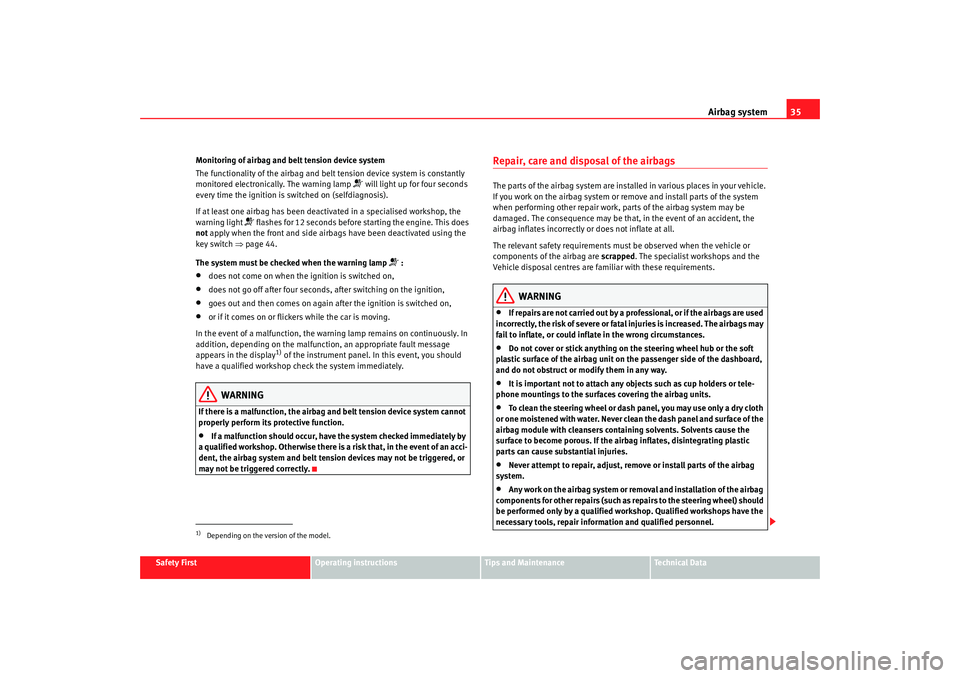
Airbag system35
Safety First
Operating instructions
Tips and Maintenance
Te c h n i c a l D a t a
Monitoring of airbag and belt tension device system
The functionality of the airbag and belt tension device system is constantly
monitored electronically. The warning lamp
will light up for four seconds
every time the ignition is switched on (selfdiagnosis).
If at least one airbag has been deactivated in a specialised workshop, the
warning light
flashes for 12 seconds before starting the engine. This does
not apply when the front and side airbags have been deactivated using the
key switch ⇒page 44.
The system must be checked when the warning lamp
:
•
does not come on when the ignition is switched on,
•
does not go off after four seconds, after switching on the ignition,
•
goes out and then comes on again after the ignition is switched on,
•
or if it comes on or flickers while the car is moving.
In the event of a malfunction, the warning lamp remains on continuously. In
addition, depending on the malfunction, an appropriate fault message
appears in the display
1) of the instrument panel. In this event, you should
have a qualified workshop check the system immediately.
WARNING
If there is a malfunction, the airbag and belt tension device system cannot
properly perform its protective function.•
If a malfunction should occur, have the system checked immediately by
a qualified workshop. Otherwise there is a risk that, in the event of an acci-
dent, the airbag system and belt tension devices may not be triggered, or
may not be triggered correctly.
Repair, care and disposal of the airbagsThe parts of the airbag system are installed in various places in your vehicle.
If you work on the airbag system or remove and install parts of the system
when performing other repair work, parts of the airbag system may be
damaged. The consequence may be that, in the event of an accident, the
airbag inflates incorrectly or does not inflate at all.
The relevant safety requirements must be observed when the vehicle or
components of the airbag are scrapped. The specialist workshops and the
Vehicle disposal centres are familiar with these requirements.
WARNING
•
If repairs are not carried out by a professional, or if the airbags are used
incorrectly, the risk of severe or fatal injuries is increased. The airbags may
fail to inflate, or could inflate in the wrong circumstances.
•
Do not cover or stick anything on the steering wheel hub or the soft
plastic surface of the airbag unit on the passenger side of the dashboard,
and do not obstruct or modify them in any way.
•
It is important not to attach any objects such as cup holders or tele-
phone mountings to the surfaces covering the airbag units.
•
To clean the steering wheel or dash panel, you may use only a dry cloth
or one moistened with water. Never clean the dash panel and surface of the
airbag module with cleansers containing solvents. Solvents cause the
surface to become porous. If the airbag inflates, disintegrating plastic
parts can cause substantial injuries.
•
Never attempt to repair, adjust, remove or install parts of the airbag
system.
•
Any work on the airbag system or removal and installation of the airbag
components for other repairs (such as repairs to the steering wheel) should
be performed only by a qualified workshop. Qualified workshops have the
necessary tools, repair information and qualified personnel.
1)Depending on the version of the model.
alhambra_aleman.book Seite 35 Montag, 23. M‰ rz 2009 1:12 13
Page 67 of 285
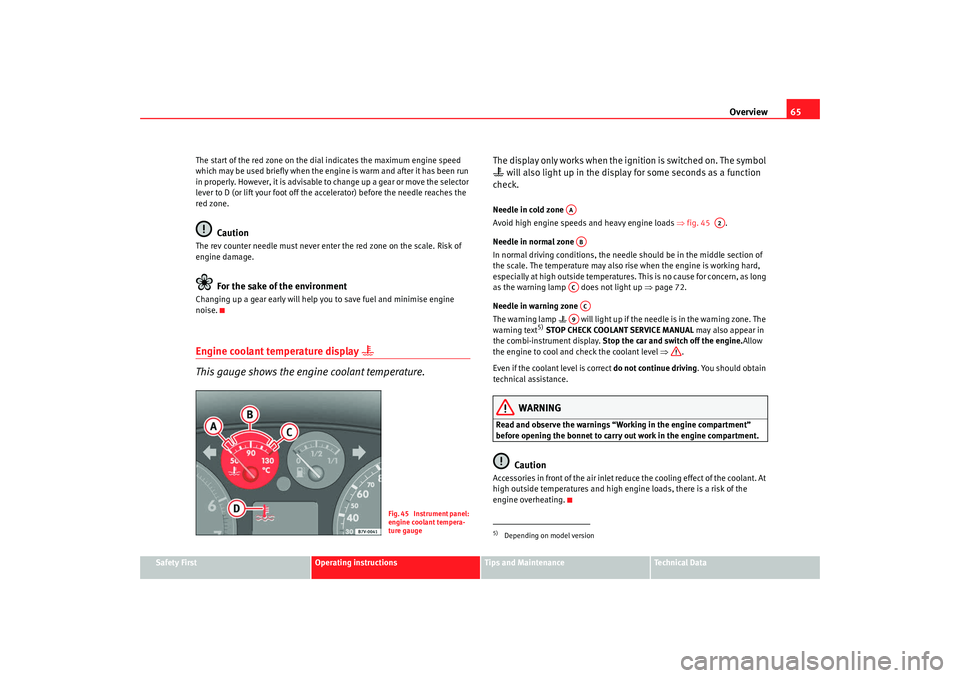
Overview65
Safety First
Operating instructions
Tips and Maintenance
Te c h n i c a l D a t a
The start of the red zone on the dial indicates the maximum engine speed
which may be used briefly when the engine is warm and after it has been run
in properly. However, it is advisable to change up a gear or move the selector
lever to D (or lift your foot off the accelerator) before the needle reaches the
red zone.
Caution
The rev counter needle must never enter the red zone on the scale. Risk of
engine damage.
For the sake of the environment
Changing up a gear early will help you to save fuel and minimise engine
noise.Engine coolant temperature display
This gauge shows the engine coolant temperature.
The display only works when the ignition is switched on. The symbol will also light up in the display for some seconds as a function
check.Needle in cold zone
Avoid high engine speeds and heavy engine loads ⇒fig. 45 .
Needle in normal zone
In normal driving conditions, the needle should be in the middle section of
the scale. The temperature may also rise when the engine is working hard,
especially at high outside temperatures. This is no cause for concern, as long
as the warning lamp does not light up ⇒page 72.
Needle in warning zone
The warning lamp will light up if the needle is in the warning zone. The
warning text
5) STOP CHECK COOLANT SERVICE MANUAL may also appear in
the combi-instrument display. Stop the car and switch off the engine. Allow
the engine to cool and check the coolant level ⇒.
Even if the coolant level is correct do not continue driving . You should obtain
technical assistance.
WARNING
Read and observe the warnings “Working in the engine compartment”
before opening the bonnet to carry out work in the engine compartment.
Caution
Accessories in front of the air inlet reduce the cooling effect of the coolant. At
high outside temperatures and high engine loads, there is a risk of the
engine overheating.
F i g . 4 5 I n s t r u m e n t p a n e l :
engine coolant tempera-
ture gauge
5)Depending on model version
AA
A2
ABACAC
A9
alhambra_aleman.book Seite 65 Montag, 23. M‰ rz 2009 1:12 13
Page 68 of 285
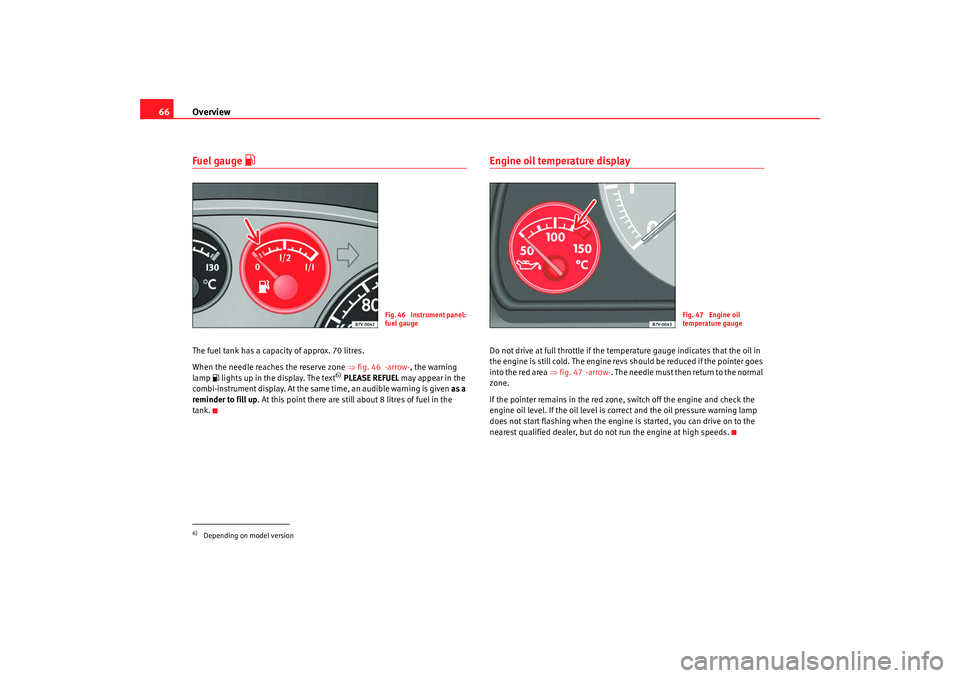
Overview
66Fuel gauge
The fuel tank has a capacity of approx. 70 litres.
When the needle reaches the reserve zone ⇒fig. 46 -arrow- , the warning
lamp lights up in the display. The text
6) PLEASE REFUEL may appear in the
combi-instrument display. At the same time, an audible warning is given as a
reminder to fill up . At this point there are still about 8 litres of fuel in the
tank.
Engine oil temperature displayDo not drive at full throttle if the temperature gauge indicates that the oil in
the engine is still cold. The engine revs should be reduced if the pointer goes
into the red area ⇒ fig. 47 -arrow-. The needle must then return to the normal
zone.
If the pointer remains in the red zone, switch off the engine and check the
engine oil level. If the oil level is correct and the oil pressure warning lamp
does not start flashing when the engine is started, you can drive on to the
nearest qualified dealer, but do not run the engine at high speeds.
6)Depending on model version
Fig. 46 Instrument panel:
fuel gauge
Fig. 47 Engine oil
temperature gauge
alhambra_aleman.book Seite 66 Montag, 23. M‰ rz 2009 1:12 13
Page 71 of 285

Overview69
Safety First
Operating instructions
Tips and Maintenance
Te c h n i c a l D a t a
Display in the instrument panel Fault messages
Faults are shown by warning lamps and / or as symbols with
warning and information reports on the display.The system runs a check on certain components and functions when the igni-
tion is switched on and while the vehicle is moving. Functional problems are
shown by warning lamps and / or red or yellow symbols with fault texts on the combi-instrument. Depending on the exact nature of the functional problem,
audible warnings may also be given.
Note
•
Th e size o f t h e d isp l ay d e p en ds on th e ty p e o f com b i - ins tr u m e n t y ou h av e
fitted. In some models, the combi-instrument does not have an integrated
display.
•
In addition to warning messages given on a fault, you will receive informa-
tion in the display on procedures or will be asked to carry out certain tasks.
Overview of selected fault messages
Fault messages are displayed on the combi-instrument display.The following overview does not show all fault messages. Not all fault
messages are displayed with a symbol. Warning symbols (priority 1)
If the symbol lights up again after a fault has been corrected, you should stop
the vehicle immediately, switch off the engine and seek professional advice.
Fault message
Symbol Action
STOP BRAKE FAULT SERVICE MANUAL
Stop the car, turn the engine off and check the brake fluid level
⇒ page 223.
HANDBRAKE ON
Release the handbrake.
STOP BRAKE FAULT SERVICE MANUAL
and
Stop the car, turn the engine off and seek professional help ⇒page 181
STOP CHECK COOLANT SERVICE MANUAL
Checking coolant level ⇒ page 218
alhambra_aleman.book Seite 69 Montag, 23. M‰ rz 2009 1:12 13
Page 73 of 285
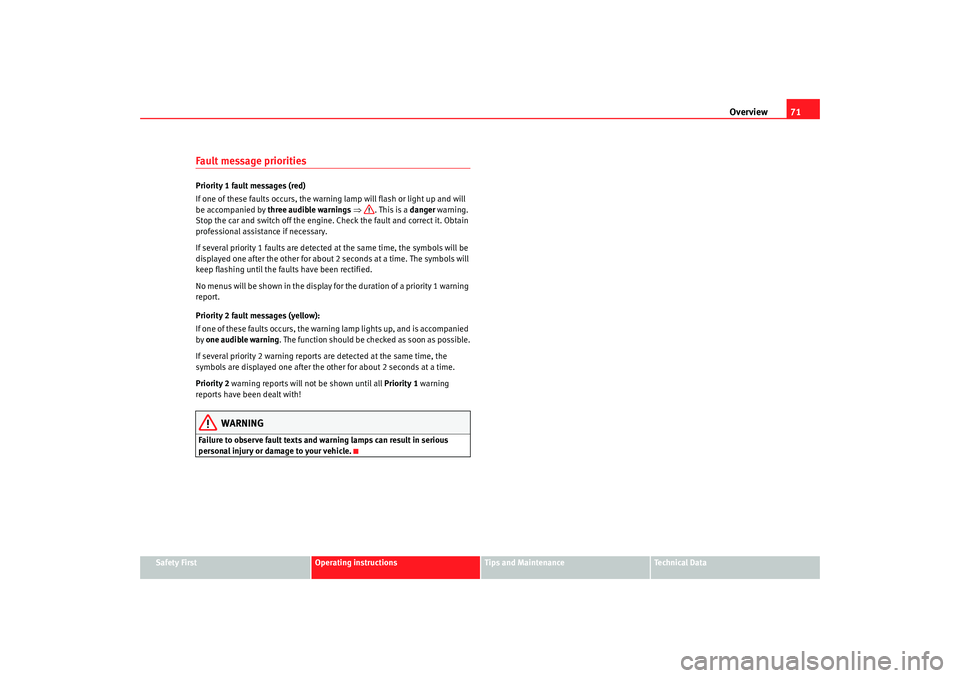
Overview71
Safety First
Operating instructions
Tips and Maintenance
Te c h n i c a l D a t a
Fault message prioritiesPriority 1 fault messages (red)
If one of these faults occurs, the warning lamp will flash or light up and will
be accompanied by three audible warnings ⇒ . This is a danger warning.
Stop the car and switch off the engine. Check the fault and correct it. Obtain
professional assistance if necessary.
If several priority 1 faults are detected at the same time, the symbols will be
displayed one after the other for about 2 seconds at a time. The symbols will
keep flashing until the faults have been rectified.
No menus will be shown in the display for the duration of a priority 1 warning
report.
Priority 2 fault messages (yellow):
If one of these faults occurs, the warning lamp lights up, and is accompanied
by one audible warning . The function should be checked as soon as possible.
If several priority 2 warning reports are detected at the same time, the
symbols are displayed one after the other for about 2 seconds at a time.
Priority 2 warning reports will not be shown until all Priority 1 warning
reports have been dealt with!
WARNING
Failure to observe fault texts and warning lamps can result in serious
personal injury or damage to your vehicle.
alhambra_aleman.book Seite 71 Montag, 23. M‰ rz 2009 1:12 13
Page 77 of 285
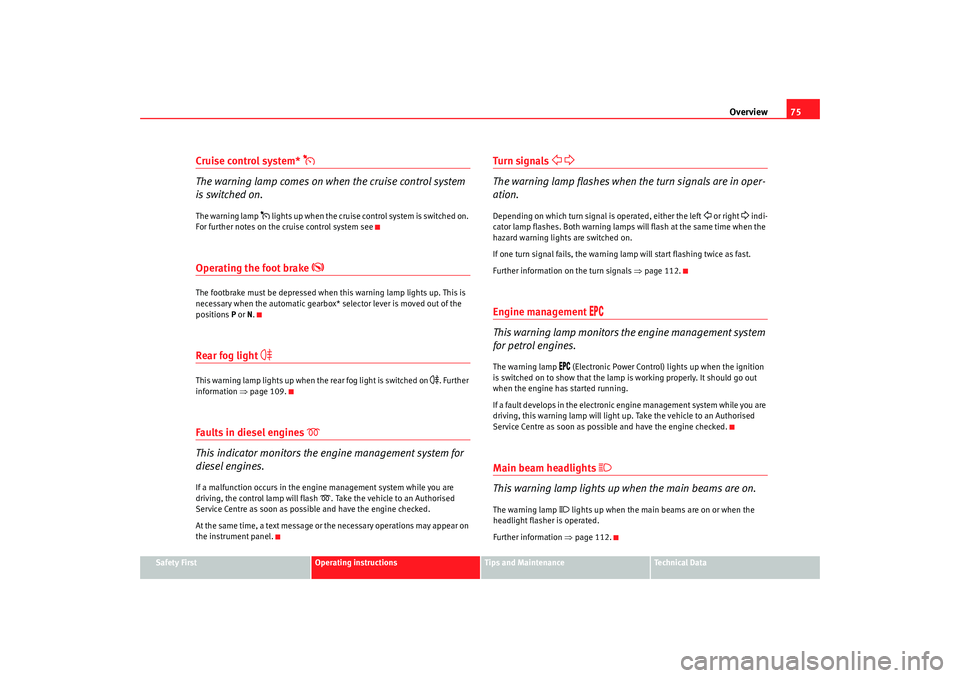
Overview75
Safety First
Operating instructions
Tips and Maintenance
Te c h n i c a l D a t a
Cruise control system*
The warning lamp comes on when the cruise control system
is switched on.The warning lamp
lights up when the cruise control system is switched on.
For further notes on the cruise control system see
Operating the foot brake
The footbrake must be depressed when this warning lamp lights up. This is
necessary when the automatic gearbox* selector lever is moved out of the
positions P or N.Rear fog light
This warning lamp lights up when the rear fog light is switched on
. Further
information ⇒page 109.
Faults in diesel engines
This indicator monitors the engine management system for
diesel engines.
If a malfunction occurs in the engine management system while you are
driving, the control lamp will flash
. Take the vehicle to an Authorised
Service Centre as soon as possible and have the engine checked.
At the same time, a text message or the necessary operations may appear on
the instrument panel.
Turn si gnals
The warning lamp flashes when the turn signals are in oper-
ation.Depending on which turn signal is operated, either the left
or right
indi-
cator lamp flashes. Both warning lamps will flash at the same time when the
hazard warning lights are switched on.
If one turn signal fails, the warning lamp will start flashing twice as fast.
Further information on the turn signals ⇒page 112.
Engine management
This warning lamp monitors the engine management system
for petrol engines.
The warning lamp
(Electronic Power Control) lights up when the ignition
is switched on to show that the lamp is working properly. It should go out
when the engine has started running.
If a fault develops in the electronic engine management system while you are
driving, this warning lamp will light up. Take the vehicle to an Authorised
Service Centre as soon as possible and have the engine checked.
Main beam headlights
This warning lamp lights up when the main beams are on.The warning lamp
lights up when the main beams are on or when the
headlight flasher is operated.
Further information ⇒page 112.
alhambra_aleman.book Seite 75 Montag, 23. M‰ rz 2009 1:12 13
Page 78 of 285
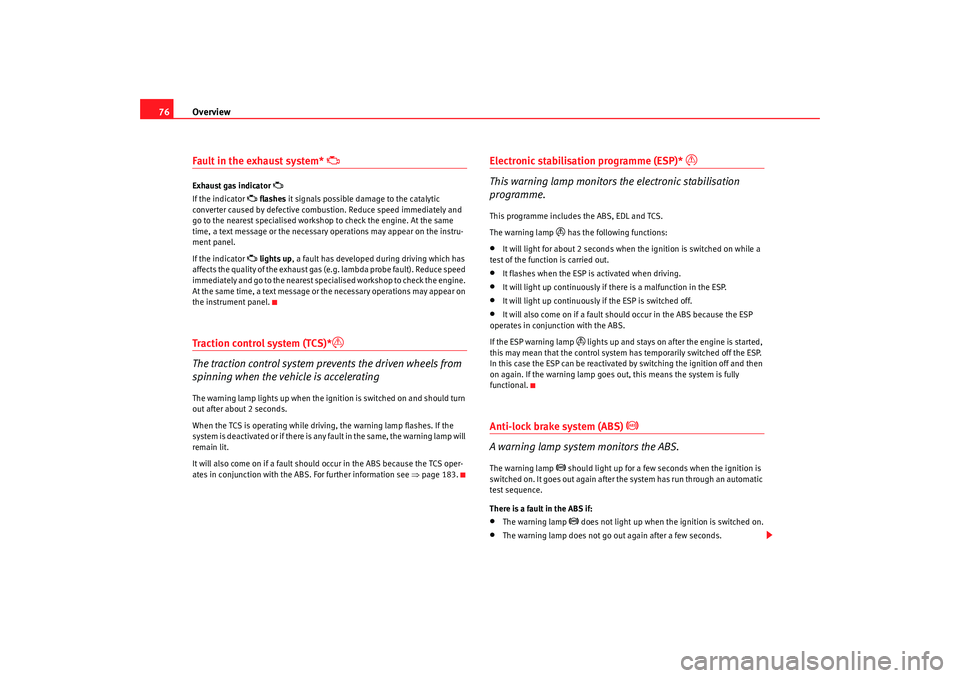
Overview
76Fault in the exhaust system*
Exhaust gas indicator
If the indicator
flashes it signals possible damage to the catalytic
converter caused by defective combustion. Reduce speed immediately and
go to the nearest specialised workshop to check the engine. At the same
time, a text message or the necessary operations may appear on the instru-
ment panel.
If the indicator lights up , a fault has developed during driving which has
affects the quality of the exhaust gas (e.g. lambda probe fault). Reduce speed
immediately and go to the nearest specialised workshop to check the engine.
At the same time, a text message or the necessary operations may appear on
the instrument panel.
Traction control system (TCS)*
The traction control system prevents the driven wheels from
spinning when the vehicle is acceleratingThe warning lamp lights up when the ignition is switched on and should turn
out after about 2 seconds.
When the TCS is operating while driving, the warning lamp flashes. If the
system is deactivated or if there is any fault in the same, the warning lamp will
remain lit.
It will also come on if a fault should occur in the ABS because the TCS oper-
ates in conjunction with the ABS. For further information see ⇒ page 183.
Electronic stabilisation programme (ESP)*
This warning lamp monitors the electronic stabilisation
programme.
This programme includes the ABS, EDL and TCS.
The warning lamp
has the following functions:
•
It will light for about 2 seconds when the ignition is switched on while a
test of the function is carried out.
•
It flashes when the ESP is activated when driving.
•
It will light up continuously if there is a malfunction in the ESP.
•
It will light up continuously if the ESP is switched off.
•
It will also come on if a fault should occur in the ABS because the ESP
operates in conjunction with the ABS.
If the ESP warning lamp
lights up and stays on after the engine is started,
this may mean that the control system has temporarily switched off the ESP.
In this case the ESP can be reactivated by switching the ignition off and then
on again. If the warning lamp goes out, this means the system is fully
functional.
Anti-lock brake system (ABS)
A warning lamp system monitors the ABS.
The warning lamp
should light up for a few seconds when the ignition is
switched on. It goes out again after the system has run through an automatic
test sequence.
There is a fault in the ABS if:
•
The warning lamp
does not light up when the ignition is switched on.
•
The warning lamp does not go out again after a few seconds.
alhambra_aleman.book Seite 76 Montag, 23. M‰ rz 2009 1:12 13
Page 79 of 285
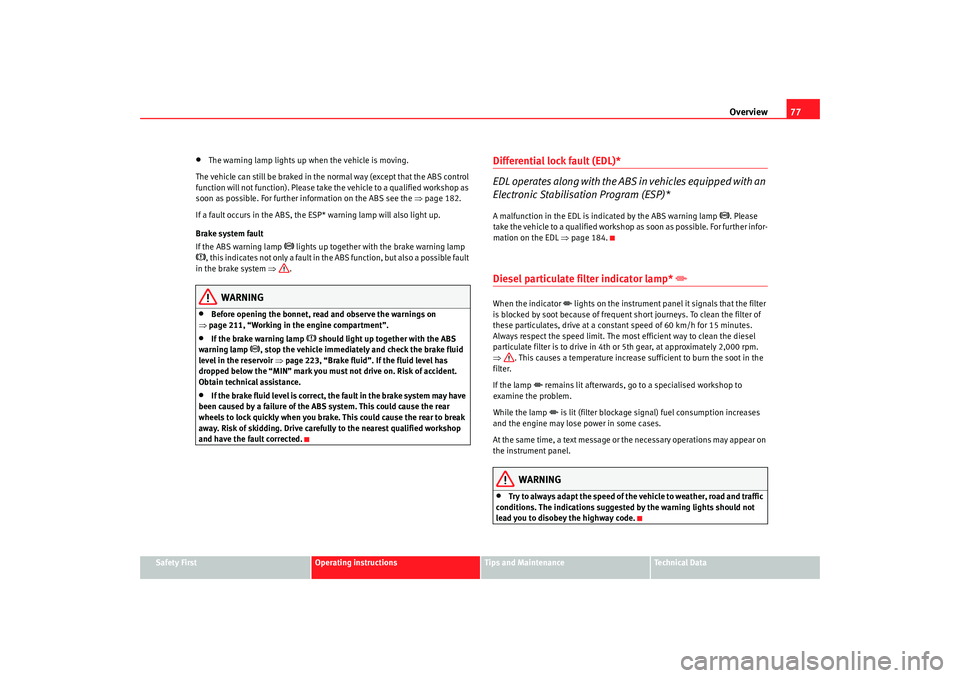
Overview77
Safety First
Operating instructions
Tips and Maintenance
Te c h n i c a l D a t a
•
The warning lamp lights up when the vehicle is moving.
The vehicle can still be braked in the normal way (except that the ABS control
function will not function). Please take the vehicle to a qualified workshop as
soon as possible. For further information on the ABS see the ⇒page 182.
If a fault occurs in the ABS, the ESP* warning lamp will also light up.
Brake system fault
If the ABS warning lamp
lights up together with the brake warning lamp
, this indicates not only a fault in the ABS function, but also a possible fault
in the brake system ⇒ .
WARNING
•
Before opening the bonnet, read and observe the warnings on
⇒ page 211, “Working in the engine compartment”.
•
If the brake warning lamp
should light up together with the ABS
warning lamp
, stop the vehicle immediately and check the brake fluid
level in the reservoir ⇒page 223, “Brake fluid”. If the fluid level has
dropped below the “MIN” mark you must not drive on. Risk of accident.
Obtain technical assistance.
•
If the brake fluid level is correct, the fault in the brake system may have
been caused by a failure of the ABS system. This could cause the rear
wheels to lock quickly when you brake. This could cause the rear to break
away. Risk of skidding. Drive carefully to the nearest qualified workshop
and have the fault corrected.
Differential lock fault (EDL)*
EDL operates along with the ABS in vehicles equipped with an
Electronic Stabilisation Program (ESP)*A malfunction in the EDL is indicated by the ABS warning lamp
. Please
take the vehicle to a qualified workshop as soon as possible. For further infor-
mation on the EDL ⇒page 184.
Diesel particulate filter indicator lamp*
When the indicator
lights on the instrument panel it signals that the filter
is blocked by soot because of frequent short journeys. To clean the filter of
these particulates, drive at a constant speed of 60 km/h for 15 minutes.
Always respect the speed limit. The most efficient way to clean the diesel
particulate filter is to drive in 4th or 5th gear, at approximately 2,000 rpm.
⇒ . This causes a temperature increase sufficient to burn the soot in the
filter.
If the lamp
remains lit afterwards, go to a specialised workshop to
examine the problem.
While the lamp is lit (filter blockage signal) fuel consumption increases
and the engine may lose power in some cases.
At the same time, a text message or the necessary operations may appear on
the instrument panel.
WARNING
•
Try to always adapt the speed of the vehicle to weather, road and traffic
conditions. The indications suggested by the warning lights should not
lead you to disobey the highway code.
alhambra_aleman.book Seite 77 Montag, 23. M‰ rz 2009 1:12 13
Page 81 of 285

Overview79
Safety First
Operating instructions
Tips and Maintenance
Te c h n i c a l D a t a
Tailgate open display*
When the ignition is switched on, the warning light indicates that the tailgate
is open.
The warning light only goes off when the tailgate is completely closed.Washer fluid
This warning lamp lights up to indicate that the windscreen
washer level is too low.This serves as a reminder to fill up the reservoir at the earliest opportunity
⇒ page 220.Door open display*
This light comes on when a door is open or incorrectly closed.Brake pad wear indicator*
As the brake pad wear indicator only monitors the front brake pads, it is advis-
able to have the rear brake pads inspected at the same time.
WARNING
Have the brake pads inspected immediately by a qualified dealership if the
warning display
lights up.
Engine oil pressure
The warning light indicates that the engine oil pressure is too
low or that the oil gauge does not operate correctly.It lights up or flashes in red (oil pressure too low)
If the warning light lights up or starts to flash in red while driving, a sound
signal will also be emitted three times when the engine speed exceeds 1500
rpm. Stop and switch off the engine: check the oil level and replace if neces-
sary ⇒page 216.
If the warning light flashes even though the oil level is correct, do not
continue driving The engine should not be turning even at idle speed. Obtain
technical assistance.
If, while driving, the engine speed falls to below idling speed, the oil pressure
warning light may come on. Increase the engine speed by accelerating or
dropping to a lower gear.
A yellow light comes on (oil level* too low)
If the warning light comes on in yellow, this indicates that the oil level is too
low. Switch off engine, check oil level, replacing where necessary.
When the bonnet is opened the oil level warning will fall to zero. But if it is not
topped with oil, the light will come back on after approximately 100 km.
Yellow flashing (defective oil level*)
If the oil gauge is faulty, a sound signal is emitted and the warning light
flashes several times.
At the same time, a warning appears briefly on the on board computer
display*. The engine should immediately be checked by a Technical Service
Centre.
From the moment the defect appears until the engine is checked, the level of
oil should be constantly monitored, preferably every time the vehicle is
refuelled.
alhambra_aleman.book Seite 79 Montag, 23. M‰ rz 2009 1:12 13